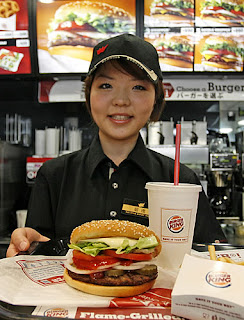On May 7, 2007, the Wall Street Journal published an article titled "Developing Nation: Japanese Clothiers Update Their Lines," which regrettably had nothing to do with a new, fantastic line from the likes of Yamamoto, Kawakubo, Kenzo, Watanabe, Mori, and Miyake (read the article
HERE; but rather, it had all to do with the expanding girth of the female Japanese population.
Japanese used to subsist on a vegetable-and-fish diet, but in recent times this has changed with the advent of the less-than-healthy American import such as:
Krispy Kreme (in Shinjuku), Cold Stone Creamery (in Roppongi), and now the inevitable MacDonald's MegaMac
that featured not two, not three, but FOUR beef patties in a three-bun sandwich (read the article HERE).
Some tends to want to put the blame on the American side for exporting such unhealthy and irresponsible food like those mentioned above, but there has to be a demand in Japan that those things are actually here. The almost two-hour wait at Krispy Kreme (six months since its opening) and the line at Cold Stone Creamery (more than a year after it opened its counter) is a testament to this. Part of the reasons may be the "American-ness" or the foreign aspect of it combined with the novelty of the item that appealed to the masses in major cities like Tokyo and Hong Kong.
Not wanting to be left in the dust, local food producers competed with their foreign brethren to attract the appetite of the masses; the release of Dekao (Huge King) and Super Cup instant noodles are but two examples of this. According to the Mainichi article, "One product even contains a staggering 1,100 calories, almost half the daily recommended 2,500-calorie intake of the average Japanese male." I noticed this a couple of years ago when I encountered a bigger package of spicy Korean noodles sold here in Japan (and in California): it used to be that these "ramen" or noodles packages were relatively small and would be just enough for one quick meal; but this particular spicy Korean noodle package was almost twice the size of their predecessors. Freshness Burger, a Japanese burger chain, came up with Classic Double-Double Burger; meanwhile, American-import Wendy's answer was the Big Triple.
I suppose one has to wait to see when the line will diminish, but for now, supersizing and girth-expanding diet are here to stay. Guess who is coming back this month to Japan after folding its tent for being expensive in their former foray into the Japanese food market? None other than the originator of the Whoppers: Burger King. The big department stores that used to relegate the "big sizes" to one corner can now safely "expand" their collection.



